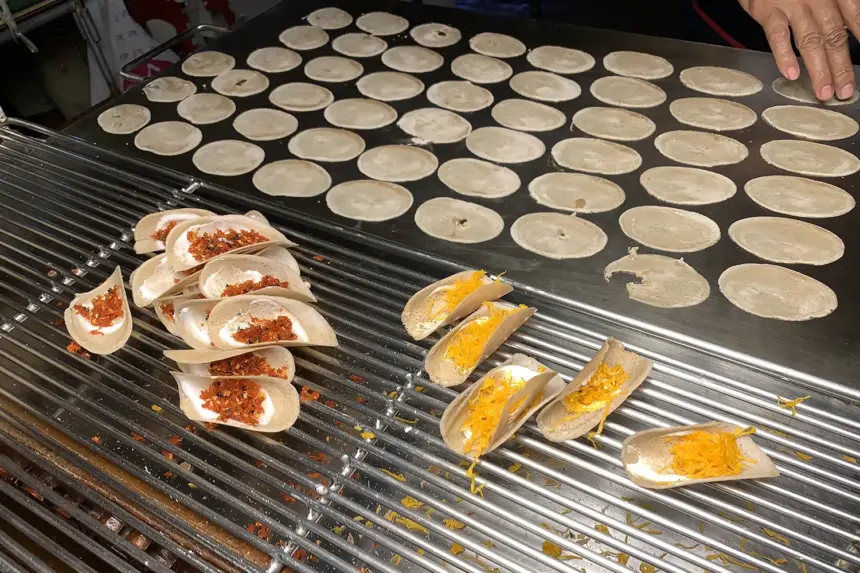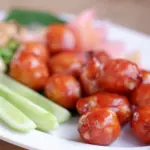Thai Food: Khanom Buang (ขนมเบื้อง)
Khanom Buang (ขนมเบื้อง), also known as Thai crispy pancakes or Thai crepes, is one of Thailand’s most cherished and unique street food delicacies. These thin, crispy pancakes have been a part of Thai culinary culture for centuries, offering a perfect blend of sweet and savory flavors. Whether you encounter them at bustling street markets or small food stalls in Bangkok, Khanom Buang holds a special place in Thai dessert traditions.
In this article, we will explore the history of Khanom Buang, its ingredients, how it is made, and why it remains so popular among locals and tourists alike. We will also dive into its cultural significance and its evolution over time, making it a staple in Thai street food culture.
History of Khanom Buang
The origins of Khanom Buang can be traced back to Ayutthaya, an ancient kingdom in Thailand that flourished between the 14th and 18th centuries. During this period, trade and cultural exchanges with neighboring countries, including India and Persia, influenced Thai cuisine. Khanom Buang was inspired by Indian pancakes known as dosa, but it was adapted to suit Thai tastes, with a more delicate texture and the use of local ingredients.
Historically, Khanom Buang was considered a snack for the nobility and was often served at royal feasts. Over time, it became more widely available and evolved into a popular street food. Today, Khanom Buang can be found in food markets and street stalls across Thailand, where it continues to captivate locals and tourists alike with its crispy texture and flavorful fillings.
Ingredients of Khanom Buang
The ingredients used in Khanom Buang are simple yet carefully selected to create the perfect combination of flavors and textures. The main components include:
- Batter: The pancake batter is made from rice flour, mung bean flour, and water. Some recipes also include egg yolks, which help give the pancakes their crispiness. The batter is spread thinly onto a hot griddle to create a crispy crepe-like base.
- Coconut Cream: Once the batter is spread, a layer of coconut cream is added to the top of the pancake. The rich, creamy flavor of the coconut cream complements the crispy texture of the pancake, providing a contrasting richness that elevates the overall taste.
- Fillings: The fillings are what make Khanom Buang truly special. There are two primary types of fillings: sweet and savory.
- Sweet filling: This typically consists of shredded coconut, sugar, and egg yolk threads (known as foi thong). The combination of sweet coconut and the rich, golden threads of egg yolk creates a delicate sweetness that melts in your mouth.
- Savory filling: The savory version often includes minced shrimp, garlic, coriander, and sometimes grated coconut mixed with spices. The savory filling is spiced but not overly hot, giving a more complex, aromatic flavor to the pancake.
- Toppings: A variety of toppings are used to garnish the pancakes, such as chopped green onions, dried shrimp, or cilantro. These toppings add color, texture, and an extra layer of flavor to the final dish.
The Making of Khanom Buang
Making Khanom Buang is an art form that requires skill and precision. Vendors can be seen expertly crafting these delicate pancakes at street stalls, a process that fascinates onlookers and attracts crowds.
Here’s a step-by-step guide to how Khanom Buang is made:
- Preparing the Batter: The batter for Khanom Buang is prepared by mixing rice flour and mung bean flour with water. The result is a smooth, slightly runny batter that can be easily spread on the griddle.
- Spreading the Batter: A small spoonful of batter is placed on a hot griddle, and using the back of the spoon, it is spread out into a thin, circular shape. The pancake is cooked until it becomes crisp, which takes just a minute or two.
- Adding the Coconut Cream: Once the pancake is nearly cooked, a dollop of coconut cream is added to the center of the pancake. The coconut cream is spread across the surface, creating a creamy contrast to the crispiness of the pancake.
- Filling the Pancake: Depending on whether a sweet or savory version is being made, the appropriate filling is placed on top of the coconut cream. For the sweet version, egg yolk threads and coconut are added, while the savory version includes a mixture of shrimp, garlic, and spices.
- Garnishing and Folding: After the fillings are added, the pancake is garnished with toppings like chopped scallions, cilantro, or dried shrimp. The pancake is then folded in half, creating a taco-like shape, and served immediately while still warm.
The Evolution of Khanom Buang
Over the years, Khanom Buang has evolved in both appearance and flavor, adapting to modern tastes while maintaining its traditional roots. Some innovative vendors have introduced new variations of Khanom Buang, using ingredients like chocolate, fruit jams, or even whipped cream to cater to the growing demand for fusion cuisine. While these modern versions add a contemporary twist, the classic sweet and savory fillings remain the most popular and beloved options.
The accessibility of Khanom Buang has also changed. Once considered a snack for the wealthy and elite, today it can be enjoyed by anyone, with vendors offering affordable and freshly made pancakes in markets across Thailand. The rise of tourism has further boosted its popularity, with visitors from around the world eager to try this unique Thai treat.
Cultural Significance of Khanom Buang
Khanom Buang is more than just a tasty snack; it is a representation of Thailand’s rich culinary history and cultural identity. As a dish that has been passed down through generations, it is a testament to the enduring appeal of traditional Thai street food.
In Thai culture, food is often associated with community and celebration, and Khanom Buang plays an important role in local festivals and gatherings. It is a common sight at temple fairs, where vendors set up stalls to make and sell freshly prepared pancakes to festival-goers. The act of sharing and enjoying Khanom Buang with friends and family is an integral part of the Thai street food experience.
Moreover, Khanom Buang is a symbol of Thai innovation and creativity. The delicate balance of flavors and textures in each pancake showcases the Thai ability to combine contrasting elements — such as sweet and savory, creamy and crispy — into one harmonious dish. This balance is a hallmark of Thai cuisine, which emphasizes the importance of combining different flavors to create a satisfying and memorable meal.
Why Khanom Buang Remains Popular
Khanom Buang has remained a favorite street food for several reasons:
- Unique Flavor Combination: The combination of crispy pancake, creamy coconut, and flavorful fillings makes Khanom Buang stand out from other street foods. Its ability to cater to both sweet and savory cravings ensures that it appeals to a wide range of tastes.
- Affordability: Khanom Buang is an affordable snack, making it accessible to locals and tourists alike. Street vendors typically sell these pancakes at very reasonable prices, allowing people to enjoy a quick and delicious bite without breaking the bank.
- Portability: The compact size of Khanom Buang makes it easy to eat on the go, which is ideal for busy markets and crowded streets. The folded, taco-like shape ensures that it’s not messy to eat, making it a convenient snack for those exploring Thailand’s bustling cities.
- Cultural Experience: Eating Khanom Buang offers more than just great taste; it provides a glimpse into Thailand’s rich street food culture. Watching a vendor expertly craft the pancakes, smelling the enticing aromas, and enjoying the finished product in a vibrant market setting all contribute to the overall experience.
Conclusion
Khanom Buang (ขนมเบื้อง) is a shining example of Thai street food at its finest. With its delicate crispy pancake, rich coconut cream, and flavorful fillings, this traditional snack continues to capture the hearts and taste buds of both locals and visitors. Its long history, cultural significance, and evolving flavors make Khanom Buang a must-try for anyone seeking to experience authentic Thai cuisine.
Whether you’re enjoying a sweet version with coconut and egg yolk threads or indulging in a savory version with shrimp and spices, Khanom Buang offers a delightful culinary experience that embodies the creativity and craftsmanship of Thai street food vendors. As one of Thailand’s most beloved desserts, Khanom Buang is sure to remain a staple of the country’s vibrant food scene for generations to come.










